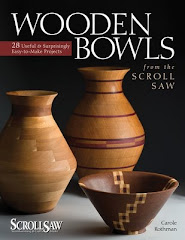Sometimes the only way to visualize a new project is to play with the pieces to see what works.
This project will be an oval box with flowers. I am working out the final arrangement by using replicas of the petals and seeing how they fit together. Loops of masking tape hold them in place and I can change things around until I get the look I want.
The leaves and petals at this stage are cut but otherwise still unfinished, and the larger flower will be purpleheart, not poplar. The components are similar enough to the finished versions to give me an idea of what it will look like.
Now that I have finalized the patterns, what remains is to prefinish the box, complete and prefinish the leaves and petals, then glue the flower components into place. Stamens will be added, and then the project can be given several coats of lacquer to finish it off.
Showing posts with label lacquer. Show all posts
Showing posts with label lacquer. Show all posts
Friday, April 3, 2015
Tuesday, November 29, 2011
Fast and easy finishing method
Since my garage shop has no ventilation, it's not the place to apply the clear coat finishes I like to use on my projects. Fortunately, the activities building that's part of my condo development has an art room, with a fan that vents to the outside. The down side of this is that I have to use the room when no one else is around, close the door, put on the fan, and get to work.
So, for me, speed is important, and over the past few years, I've streamlined my approach. First, if glue spots may be an issue, it's prudent to apply mineral spirits to the project right after I think I've finished sanding it. This makes any glue spots clearly visible. If you use some chalk to mark them, you'll be able to find them again once the mineral spirits dry. I sand off all I find, using the finest grit that does the job. If they're stubborn and I need a coarse paper to remove all traces, I sand through the grits in that area so it will finish the same as the rest of the project.
Then, I cover the table with newspaper and place the pieces to be finished on small pieces of wood. I apply a thin coat of spray shellac. This seals the wood, and reveals any glue spots I may have missed. I rub down the finish, which tends to be a little rough at this stage, using either 320 grit sandpaper, 0000 steel wool, or a sanding mop at 320 grit.
I tack everything off well (damp paper towel works for me if I'm careful) and apply several coats of clear gloss spray lacquer. This dries very quickly, and between each coat, I check for sags or roughness, and rub them down with the 0000 steel wool. When I've coated the projects to my satisfaction, I give them an overnight dry, then a final rubdown with 0000 steel wool for a soft matte finish.
Since the building is climate controlled, humidity and temperature is not a factor, and I can often complete the entire job within 2 hours or so. Then, I clean up my materials, turn off the fan, and no one even knows I was there!
Labels:
lacquer,
shellac,
wood boxes
Thursday, September 9, 2010
Dealing with glue spots

Some of my projects involve a lot of fidgety gluing and glue spots have an annoying way of showing up despite all my efforts to remove excess glue. To find the spots, I give the project a sealer coat of shellac, which causes the glue spots to stand out very visibly. I mark them with chalk as soon as the shellac is dry enough for the chalk to adhere. Once the shellac is thoroughly dry, the glue spots become harder to see. I find that shellac works better for me than mineral spirits, and gives a good base for additional coats of shellac or spray lacquer.
The project in the picture is a small box with a loopy bow. The blue tape on the top of the lid keeps the area where the loops will be glued on free of shellac. Once the box is finished, the loops are glued on and sprayed. This project is for the "Boxes with Bows" chapter of my new book, which should be out in about a year or so.
Subscribe to:
Posts (Atom)





